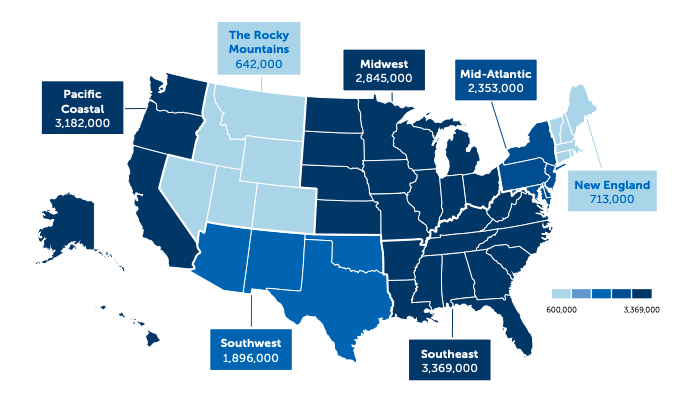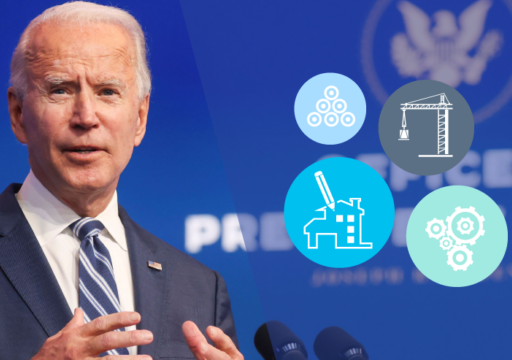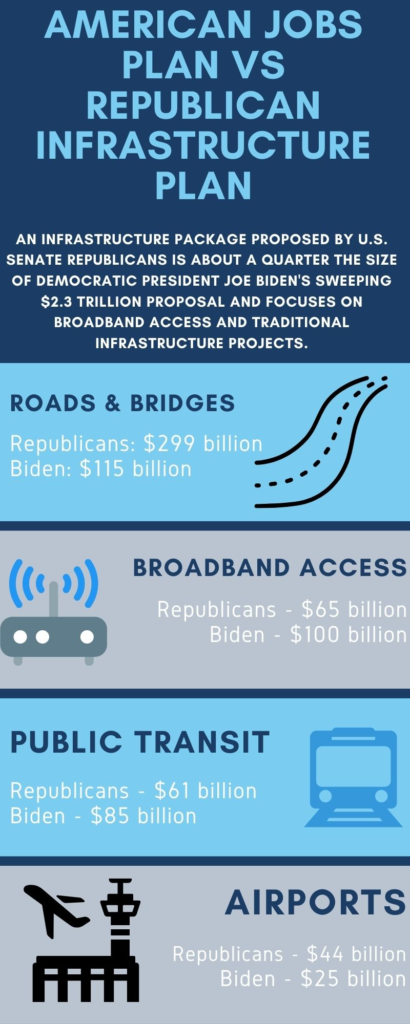
On March 31, 2021, President Biden unveiled the second part of his administration’s “Build Back Better” three-part agenda: the American Jobs Plan, an ambitious initiative to revive the country’s infrastructure. At least one early report estimates that the AJP would create as many as 13.3 million jobs in the construction industry.
The White House has positioned the over-$2 trillion plan as a way to “invest in America in a way we have not invested since we built the interstate highways and won the Space Race” — with President Biden stating that it will “create millions of good jobs, rebuild our country’s infrastructure, and position the United States to out-compete China.” In April remarks, Vice President Harris called it “the largest jobs investment since World War II.”
While an infrastructure initiative at heart, the Biden administration is largely focused on touting the jobs it will create. A report by Moody’s Analytics — the most often-cited report by the White House — states that the infrastructure plan alone would create nearly 2.7 million additional jobs in the United States.
A report from Georgetown University’s Center on Education and the Workforce gets more specific, claiming that a large majority of those jobs would be created in the construction industry. It estimates that the plan would create or save 15 million jobs over 10 years, with 89% of those jobs involved in construction — and predicts a rise in the share of infrastructure jobs from 11% to 14% of all US employment.
President Biden has further pushed the American Jobs Plan as a means to improve the nation’s “crumbling” infrastructure and address issues of racial justice and socio-economic inequity, stating, “It has never been more important for us to invest in strengthening our infrastructure and competitiveness, and in creating the good-paying, union jobs of the future.”
Despite this optimism, as federal leaders’ negotiations keep details in flux, measuring the impact of the plan on the construction industry isn’t a simple proposition. While Democratic and Republican leadership spar over proposed rises in the corporate tax rate (the Biden Administration’s main method of paying for the plan), the proposed spending has fluctuated, possibly with significant impact to the plan’s jobs creation provisions.
The White House recently made a counteroffer bringing the plan’s original $2.3 trillion in spending down to $1.7 trillion — still a stark contrast to the Republican-proposed $568 billion version of the infrastructure bill.
As the particulars of the plan go back and forth and as Congressional leaders still note that while “[partisan] groups seem further apart” than they were previously, it’s worth looking at what the different possibilities of the American Jobs Plan are and how they may come to impact the creation of the construction industry in the coming years.
Spreading the wealth
In 2021 alone, construction companies will need to fill 430,000 more positions than it did in 2020.
Research done on the American Jobs Plan heavily emphasizes the plan’s impact on overall job creation within the infrastructure sector. Moody’s report notes that “economic research is in strong agreement that public infrastructure provides a significantly positive contribution to GDP and employment” while significantly improving labor participation.
An estimate from the Bureau of Labor — made before the American Jobs Plan was announced — projects that 747,600 new construction workers will be needed to replace a retiring workforce in the next decade, putting the importance of strengthening the construction industry’s workers pipeline at the forefront of any infrastructure spending.
Georgetown University’s report specifies that the Biden Administration’s original $2.3 trillion proposal would create “3.4 million jobs in the Southeast, 3.2 million jobs in the Pacific Coastal region, 2.8 million jobs in the Midwest, 2.4 million jobs in the Mid-Atlantic, 1.9 million jobs in the Southwest, and 713,000 jobs in New England” — adding that around 13.3 million of these total jobs would be for tradesmen, construction workers, and transportation and material-moving workers.

This report also makes note of the diverse nature of educational backgrounds the plan will create jobs for, saying that it would create “8 million jobs for workers with a high school diploma or less, 4.8 million jobs for workers with more than a high school diploma but less than a bachelor’s degree, and 2.25 million jobs for workers with bachelor’s degrees and above.”
Making remarks on the plan in early April 2021, Biden noted the variance of necessity in terms of jobs themselves, saying that the plan required “long-term jobs for pipefitters, healthcare workers, those who work in steel factories and the cutting-edge labs as well.”
In his speech introducing the plan on March 31, 2021, Biden cited the importance of supporting the electrical workforce — a section of the workforce that has struggled significantly in the past year — as part of the installation of an intended 500,000 electric car charging stations as part of the country’s highway system.
Whereas electric workers are a group that has grown primarily through apprenticeships and technical schools, this project would also require an influx of urban and regional planners — workers who typically have advanced college degrees — illustrating the diversity of the workforce that Biden has stressed.
Georgetown’s report does note that 90% of current infrastructure jobs are held by men, and that job creation under the American Jobs Plan would be in more male-dominated fields.
The proposal makes attempts to address this inequity, noting that women “have endured discrimination and systematic exclusion from economic opportunities for generations,” and includes multiple proposals for programs to boost women in the construction industry after 2020’s pandemic caused “job losses and threatened economic security, eroding more than 30 years of progress in women’s labor force participation.”
These proposals also include programs to combat the marginalization of people of color in the construction industry, with the White House’s American Jobs Plan fact sheet stating “Structural racism and persistent economic inequities have undermined opportunity for millions of workers.”
“The skilled trades are in dire need of workers right now…These are steady, well-paying jobs that hold a bright future, even in an unpredictable economic climate.”
Jill Quinn, Executive Leader of PeopleReady Skilled Trades
This focus includes plans to make new jobs in clean energy, manufacturing, and infrastructure accessible to people of color and programs intended for “strengthening the pipeline” of registered apprenticeships in the construction industry for people of color.
“The skilled trades are in dire need of workers right now, with a particularly high demand for apprentice-level and skilled labor positions,” said Jill Quinn, executive leader of PeopleReady Skilled Trades. “These are steady, well-paying jobs that hold a bright future, even in an unpredictable economic climate.”
Overall, the American Jobs Plan allocates the significant majority of its spending to use public works projects to boost and diversify the construction industry. The University of Pennsylvania’s Penn Wharton Business Model projects that close to $2.1 trillion of the American Jobs Plan as proposed by the Biden Administration would be spent on “transit infrastructure, research and development, and domestic manufacturing supply chains.”

Learn more about America’s High-Speed Rails
The California High-Speed Rail Project involves hundreds of construction businesses.
Get the facts you need to know about the project — plus contact information necessary to communicate with those at the top of the payment chain.
Reducing barriers to homeownership
Dealing with legal issues impacting construction and infrastructure is another major focus of the plan, as the Biden Administration hopes to tackle laws which have historically inflated housing costs.
A key part of the plan deals with the current mounting difficulties surrounding housing and new construction. Democratic leaders say that the current national materials shortage and subsequent heavy inflation of construction prices constitutes a real housing crisis.
According to recent data, the median price for a home rose 20% from April 2020 to April 2021, while demand for homes and new construction rose during the pandemic.
Even before proposing the American Jobs Plan, President Biden has spoken about treating housing as a major concern, noting that “There is a severe shortage of affordable housing options in America.”

11 Ways President Biden Plans To Impact Construction
National analysts have been particularly concerned about the impact of rising housing on people of color who have traditionally faced racial discrimination and wealth inequality when trying to buy or construct houses.
“All their down-payment-saving becomes almost irrelevant and pointless with fast-rising home prices,” said National Association of Realtors chief economist Lawrence Yun. “If we have more supply, it gives a better chance for millennials [and] minority households to become homeowners, so we need to ensure that.”
These high prices will have an impact on government infrastructure spending as well, possibly limiting how many different projects the American Jobs Plan would be able to provide funding for.
“The current amount of investment we’re doing is barely, barely enough to keep pace with just the maintenance of the infrastructure,” said Moody’s Analytics chief economist Mark Zandi. “The package is large, but the need is very large.”
In an attempt to support an $213 billion in funding to “produce, preserve, and retrofit more than two million affordable and sustainable places to live,” the White House’s proposal calls for legislation to eliminate “exclusionary zoning and harmful land use policies” — an aspect of the plan which does have legitimate bipartisan support.
The proposal clarifies the importance of this, adding that “For decades, exclusionary zoning laws – like minimum lot sizes, mandatory parking requirements, and prohibitions on multifamily housing – have inflated housing and construction costs and locked families out of areas with more opportunities.”
The plan would establish a competitive grant program that would award funding to areas that eliminate these barriers.
Housing and Urban Development Secretary Marcia Fudge recently spoke of the importance of new housing construction as part of the overall American Jobs Plan, stating “The problem is that we have people who live in public housing and we do not have enough housing for the demand, and so we still have to take care of the people.”
“Even though I agree that we do need to find ways to move people into other housing within communities with better opportunities, we still have to deal with the issue we currently have,” Fudge added.
Parties still split on funding
The White House’s attempts to negotiate with Republican leadership may impact the final details of the plan’s economic impact, as the Democratic and Republican caucuses are still far apart on issues of spending and tax cuts.
President Biden and White House aides have attempted cuts, as evidenced by a recent proposal to Republican Senator Shelley Moore Capito (who is in charge of negotiations for Republican leadership) which reduced the plan to $1.7 trillion of spending spread over a decade.
However, as negotiation has proceeded, the Biden Administration has tried to keep the impact of any reductions away from construction-based spending. The $1.7 trillion reduced version of the plan would cut funding for “roads, bridges, and major infrastructure projects” from $159 billion to $120 billion — but would focus more cuts on broadband funding while reassigning funding for “research and development, small businesses and supply chain improvements” into a separate piece of legislation.
“If you’re a federal contractor that’s doing infrastructure-related work, this is a good time to kind of turn your eyes to the state-local market.”
Kevin Plexico, Deltek Senior Vice President for Information Solutions
A current partisan snag is the definition of what can be considered “infrastructure.” A Republican counter proposal to the American Jobs Plan allocates $568 billion for tangible infrastructure, rural broadband, and transit concerns — focusing mainly on roads, bridges, railways, and other physical projects while ignoring what it considers to be “soft,” or intangible, infrastructure.
In contrast, the White House has communicated that it intends to hold fast on funding for electric vehicles, elder care, veterans hospitals, and workforce training — all issues which Republican leadership has argued are not “infrastructure,” noting that these concerns are still “above the range of what can pass Congress with bipartisan support.”

The differences between certain aspects of these plans are stark. Where the Biden Administration’s original proposal calls for $580 billion in manufacturing spending, the Republican counter-proposal allocates $0.
In the areas of electric vehicles, school construction and repair, and home and community care, the American Jobs Plan allocates a total of $674 billion — areas which get $0 total in the Republican proposal.
Democratic leaders have maintained the importance of a broader outlook on infrastructure as part of the American Jobs Plan, and are steadfast in their intention to keep many of the elements which would have major impacts on the construction industry. In comments made at a recent session of the Senate Banking Committee, Secretary Fudge and Transportation Secretary Pete Buttigieg maintained that a successful infrastructure plan would have to include a focus on housing and surrounding elements to ease pressure on families.
“Building transit and affordable housing alongside each other can be transformational for communities and families,” Buttigieg noted.
As debate continues regarding how the package’s funding might be spent, it’s important to consider exactly where it might be spent as well.
In a recent interview, Deltek Senior Vice President for Information Solutions Kevin Plexico posited that a possible path for spending could see “two thirds of [funding]…flow down in the form of state and local funding, or higher education in K-through-12 institutions, with just about a third of it being retained at the federal level.”
As Plexico continued, “if you’re a federal contractor that’s doing infrastructure-related work, this is a good time to kind of turn your eyes to the state-local market.”